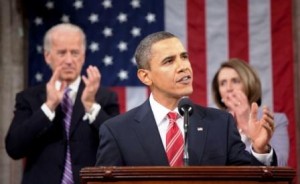On the eve of President Obama’s campaign trip today to Holland in Republican dominated western Michigan, the Department of Energy issued a report on the positive economic effects of the Administration’s spending on advanced batteries and vehicles.
The study “Recovery Act Investments: Transforming America’s Transportation Sector,” not surprisingly, claims to show how Recovery Act funds are creating new jobs.
U.S. unemployment at about 10% (reported, not actual) remains at levels not seen in at least four decades, as the Great Recession continues unabated. Michigan is particularly hard hit with a seasonally adjusted figure for June at 13.2% of its workers on the street. Critics maintain that the real number of people unemployed in Michigan is closer to 20%. Michigan has had the honor of producing the nation’s highest unemployment rate for four straight years now.
The Administration, of course, faces difficult mid-term elections because of a stalled economy, high unemployment, and soaring deficits, among other liabilities, real or imagined by increasingly hostile opponents. The sight Obama is speaking at won’t be operational for two years, and in the interim Korean-made battery cells will be imported for use in Chevy and Ford electric vehicles that taxpayers are helping to underwrite.
Obama will be saying that the construction of new plants, the addition of new manufacturing lines, as well as the installation of electric vehicle charging stations across the country are helping to build an emerging “domestic” electric vehicle industry from the ground up.
The Administration is spending your (borrowed) tax dollars on a broad portfolio of advanced vehicle technologies hoping that the monies, which, to be fair, are matched by private funds, will ultimately rebuild the “domestic” auto industry.
Obama will apparently claim that these investments are “driving down the costs associated with electric vehicles and expanding the domestic market.” A proposition that remains to be seen.
It is also expected that Obama will say that investments in batteries, for example, should help lower the cost of some electric cars by nearly 70% before the end of 2015. By then, U.S. factories will be able to produce batteries and components to support as many as 500,000 electric-drive vehicles annually. Where the customers will come from is a matter of debate between industry observers, with some saying that without massive taxpayer incentives, electric vehicles will not sell in high volumes.
Overall, it is said these investments will create tens of thousands of American jobs – far short of the hundreds of thousands, if not millions of jobs lost by the collapse of the U.S. manufacturing sector during the past decades under both Republican and Democratic Administrations – both without a coherent industrial strategy that has long been in place at our major trading partners wither either elected or totalitarian governments.
As part of the Department of Energy’s $12 billion investment in advanced vehicle technologies, it is spending more than $5 billion to “electrify” America’s transportation sector. These expenses under the American Recovery and Reinvestment Act and DOE’s Advanced Technology Vehicle Manufacturing (ATVM) Loan Program are supporting the development, manufacturing, and deployment of the batteries, components, vehicles, and chargers in an attempt to put millions of electric vehicles on U.S. roads.
The Recovery Act – all three-quarters of a trillion dollars of it – included $2.4 billion to establish 30 electric vehicle battery and component manufacturing plants and support some of the world’s first electric vehicle demonstration projects.
For every dollar of the $2.4 billion, the companies have matched it at minimum dollar for dollar. In addition, DOE’s Advanced Research Projects Agency-Energy (ARPA-E) is providing over $80 million for more than 20 research and development projects with the potential to take batteries and electric drive components beyond existing best technologies.
The Obama Administration has also provided nearly $2.6 billion in ATVM loans to Japanese owned Nissan, Tesla and Fisker to establish electric vehicle manufacturing facilities in Tennessee, California and Delaware, respectively.
Among the highlights of the report:
- Pre-Recovery Act, the U.S. produced just 2% of the world’s batteries for advanced vehicles, but due to Recovery Act investments, the U.S. will have the capacity to produce 20% of these batteries by 2012 and up to 40% by 2015.
- Nine of the nine new battery plants opening because of Recovery Act investments will have started construction by Thursday. Four will be operational by the end of the year. In addition, twenty-one other plants will make battery or electric vehicle components with the help of Recovery Act grants.
- Before the Recovery Act, high battery costs meant a car with a 100-mile range would need a battery that cost $33,000. The Administration claims that the higher-volume domestic manufacturing the Recovery Act is spurring, the cost of such a battery could come down to $16,000 by the end of 2013 and $10,000 by the end of 2015.
- Before the Recovery Act, there were fewer than 500 electric vehicle-charging locations in the U.S., but because of Recovery Act investments, there will be over 20,000 by 2012.
The plant Obama is campaigning at – Compact Power, a subsidiary of Korea-owned LG Chem – is the ninth of nine new advanced battery plants that will open because of the $2.4 billion in advanced battery and electric vehicle awards President Obama announced last August. ( See A Closer Look at How DOE Spends Your Tax Dollars)
The Compact Power plant in Holland will manufacture batteries to support a claimed 52,000 Chevy Volts a year and will supply batteries for the new electric Ford Focus. About 400 jobs will ultimately be created.

